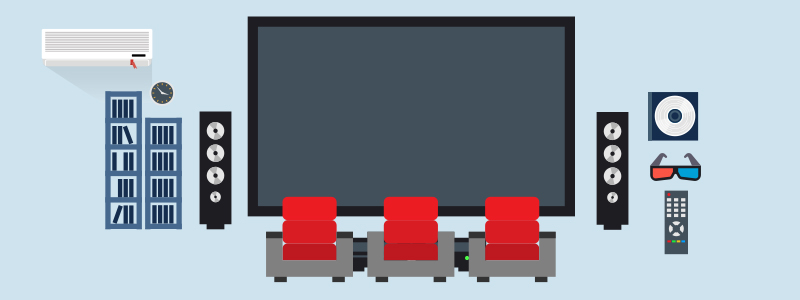
Home cinemas are the epitome of home entertainment. For film fans, sports fans or anyone who likes to be witness to a spectacle of the highest quality, not many things can beat the huge screen, crystal clear picture and immersive audio of the cinema experience. You may think that home cinemas are reserved exclusively for the mega-rich and megastars, but even though they are expensive, you can build yourself your own theatre for a price similar to that of a new hatchback.
Location

You will probably have the potential location of your new home cinema selected already. But if not, and you have more than one space to choose from, then there are some factors that need to be considered. The prospective room should be 20 feet long by 13 feet wide, and it should be situated in relative isolation from the rest of the home, so as not to disturb other people in the house.
Surround Sound

The go-to standard of home cinema audio is 7.1 surround sound. If you are unsure what the ‘7.1’ means, like a lot of people, then don’t worry: it means seven channel speakers and one subwoofer.
The channel speakers are situated as follows:
- One left (left side of the screen)
- One right (right side of the screen)
- One centre (above or below the screen)
- Two side surrounds (behind main row of seating, on the side walls)
- Two rear surrounds (on the back wall)
- The audio system should be pre-wired first, and unless you are a qualified electrical engineer yourself, you should contact a professional, qualified engineer to wire it for you.
Projector

Without a projector, you might as well watch TV in your living room on a normal television. For best results, a HD projector should be used (ultra HD or 4K if you have money to burn). Purchase an HDMI cable that is long enough to reach the projector, in order for it to receive HD video, and a CAT5 control wire that allows you to control the projector with a radio frequency (RF) remote control. The difference between a radio frequency remote and a normal remote is that you don’t have to point the former at the projector to operate it.
Lighting

Lighting is important in any room, but in a room where the main purpose is watching TV, improper lighting can significantly hamper the experience. Recessed lighting is best for a cinema room, and by connecting the lights to an RF dimmer, you will be able to subtly change the lighting during whatever you’re watching, complementing the atmosphere and not distracting any of your ‘customers’. If you prefer, you can also set the lights to dim automatically when you press play.
This lighting requires some complex wiring, so it is important that you contact a professional, qualified engineer – unless you are one yourself!
Silver screen

As the most important part of the whole set up, the screen needs to be perfect. If we are going by the dimensions that we mentioned earlier, and the room is 20 feet long by 13 feet wide, then the ideal screen size is 110-120 inches. Proscenium is the perfect choice for the frame – it hides the left, right and center speakers, whilst all other speakers can also be hidden to provide a seamless, professional look.
The receiver, which connects to your speakers and the projector, is designed to accept content from a variety of devices:
- Blu ray player
- Games console
- PC
- Satellite TV feed
- Seating
You need to be comfortable when sitting in front of the screen, so investing in top quality seating is worth the money. A cinema room that is 20 by 13 feet will comfortably house two rows of four seats, but it’s the type of seats that are in these rows that is most important. Leather recliners with cup holders on the armrests are the pinnacle of cinema seating, but be sure to elevate the back row so their view is not obscured.
Climate control
Even if your seats are as comfortable as possible, if the temperature in the room is not right, then you and your guests could get distracted and not enjoy the atmosphere or experience.
The above points are a guide to the most important features of a home cinema. It comes down to your personal tastes, your property size and how many people you plan to invite over to use your new entertainment station.
